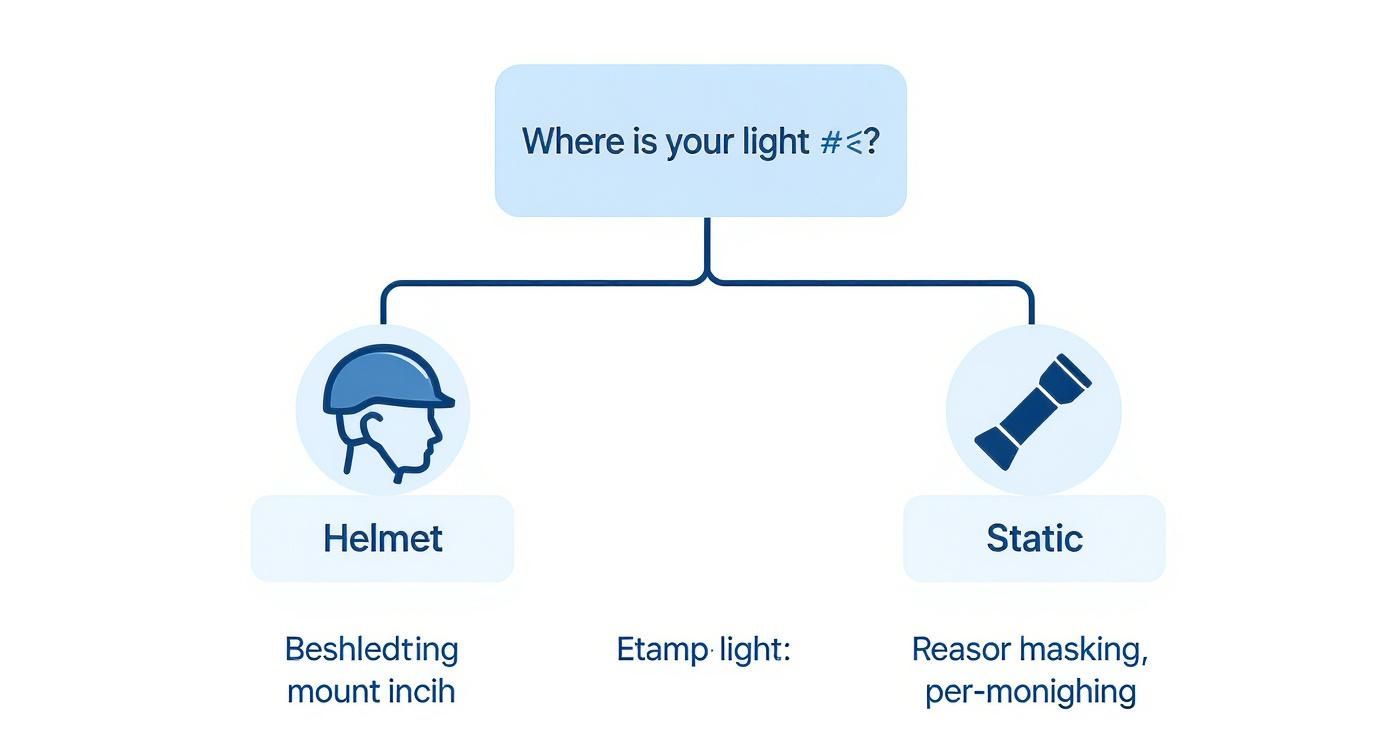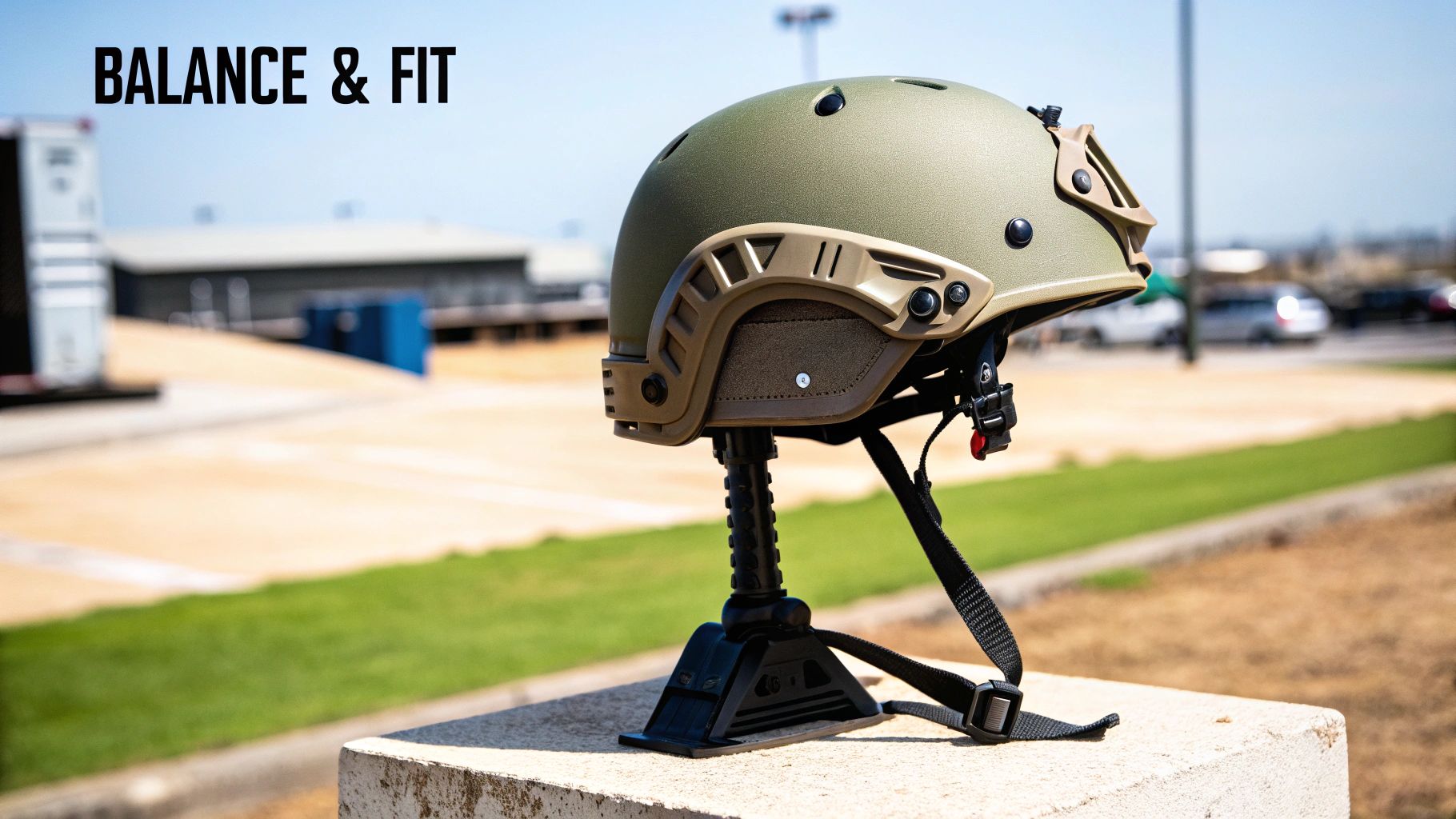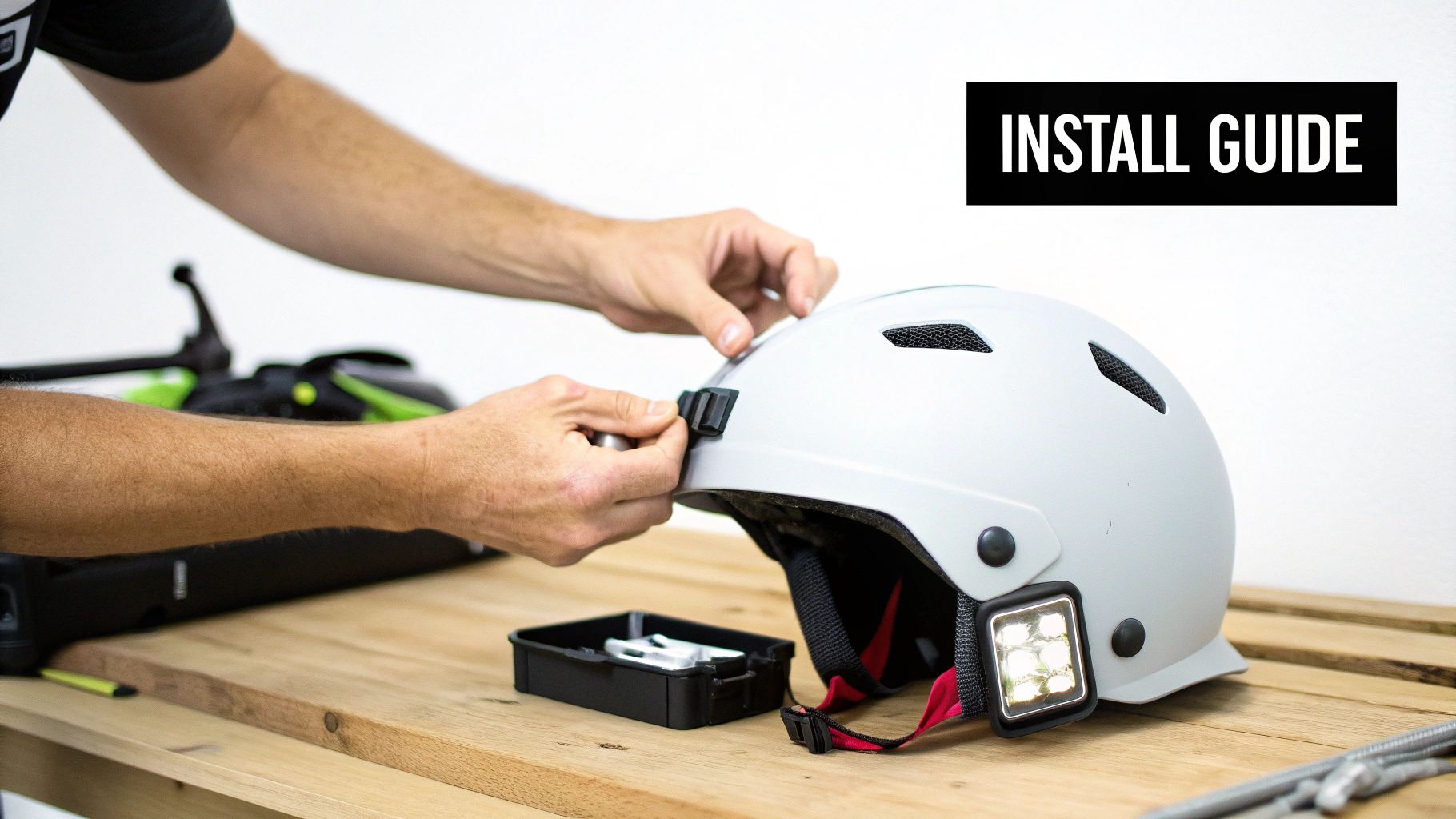Choosing Your Perfect Light Helmet Mount
At its core, a light helmet mount is a pretty simple piece of gear. It’s an accessory that lets you securely clip a flashlight right onto your helmet. But don’t let that simplicity fool you—this little tool is an absolute game-changer for anyone working or playing in the dark.
Why a Helmet Mount Transforms Your Lighting
Think about trying to navigate a dark trail or a cluttered basement. With a handheld flashlight, you’re constantly pointing the beam where you think you need to see, which isn’t always where your eyes are naturally looking. A helmet mount completely flips that script.
By attaching the light to your head, the beam follows your line of sight perfectly. It becomes an extension of your own vision, illuminating exactly what you’re focused on, the instant you look at it.
This hands-free capability is what makes it so indispensable.
- For a mountain biker, that means the light is already on that sharp corner or unexpected root before they even turn the handlebars.
- For a first responder, it means they can assess a critical situation while keeping both hands free for life-saving tasks.
This guide is all about helping you find the right mount for your helmet and your light. We’ll cover how to choose one, get it installed, and make sure it’s always ready to go when you need it most.
Breaking Down the Different Types of Mounts
When it comes to attaching a light to your helmet, you’ll find that one size definitely does not fit all. The best light helmet mount for you really boils down to your specific helmet, the light you’re using, and what you’ll be doing. Each type strikes a different balance between stability, how permanently it’s attached, and overall flexibility.
Four Main Mounting Systems
Let’s walk through the most common options you’ll encounter. For a universal solution that fits almost any helmet without permanent modification, strap mounts are the go-to. If you need something more fixed and don’t mind a permanent addition, adhesive mounts provide a strong bond.
For those in industrial settings, beefy clamp systems are designed to securely grip the brims of hard hats. And in the tactical world, rail or ARC mounts are king, offering incredible modularity and the ability to add or remove accessories in a snap. This modular approach is a core principle in tactical gear; you can see a similar philosophy in our guide to dovetail mounts for night vision goggles.
Thinking through your needs is the first step. This decision tree can help you visualize which path makes the most sense.

As the infographic shows, putting a light on your helmet is all about keeping your hands free and your light pointed exactly where you’re looking, which is a huge advantage in any dynamic situation.
A Quick Comparison of Helmet Mount Systems
To make it even clearer, let’s compare these four systems side-by-side.
| Mount Type | Attachment Method | Best For | Stability | Key Advantage |
|---|---|---|---|---|
| Strap Mount | Woven nylon/elastic straps | Universal fit on most helmets | Moderate | Versatility & non-permanent |
| Adhesive Mount | Industrial-strength adhesive pad | Smooth-surfaced helmets | High | Low profile & secure bond |
| Clamp Mount | Mechanical screw-down clamp | Industrial hard hats with brims | Very High | Rock-solid & durable |
| Rail/ARC Mount | Slides onto built-in helmet rails | Tactical & military helmets | Very High | Modularity & quick-detach |
Each of these systems has its place. The key is to match the mount’s strengths to your specific helmet and how you plan to use your light.
Finding the Right Balance of Critical Features

Once you’ve picked a general type of mount, it’s time to get into the weeds. The little details are what separate a great piece of gear from a frustrating one.
Material and Weight
Let’s start with the build material. For serious tactical applications, a rugged aluminum mount is usually the way to go for maximum durability. But if you’re using it for caving or climbing, a lighter polymer often strikes the perfect balance, shaving off precious ounces without sacrificing reliability.
Remember, every gram you add to your helmet matters. The combined weight of the mount and the light itself can create an imbalance that leads to neck fatigue after just a few hours. This is why the market for high-performance gear is booming, with the helmet lighting industry projected to hit $250 million by 2025. You can dig into the specifics in this helmet lighting industry analysis.
Adjustability and Compatibility
A fixed beam of light isn’t much use. You need a mount that offers excellent adjustability, allowing you to articulate the light and aim your beam exactly where you need it, whether that’s at your feet for navigating terrain or out in the distance. This is a non-negotiable feature.
Finally, the golden rule: check for compatibility. Make sure the mount you buy works seamlessly with your specific helmet and your specific flashlight. It’s a simple step that saves a ton of headaches. And if you’re still shopping for the light itself, our guide on how to spot genuine tactical flashlights can help you find a reliable partner for your new mount.
How Professionals and Enthusiasts Put Their Mounts to Work
A light helmet mount really proves its worth when the lights go out and the stakes are high. For professionals working in places like mines or on construction sites, it’s not just a handy tool—it’s an essential piece of safety equipment. It provides critical hands-free light in potentially dangerous, poorly lit conditions.
The push for better safety regulations is one of the big reasons these systems are becoming standard issue. If you’re interested in the data behind this trend, there’s a great breakdown on the role of helmet lighting in worker safety.
It’s that same hands-free advantage that gives outdoor adventurers the confidence to tackle a tricky trail. Think about navigating a cave system, scaling a rock face at dusk, or hitting a mountain bike trail after sundown. For military and law enforcement, it’s about gaining a tactical edge, providing the situational awareness needed for night operations where split-second decisions are everything.
Getting Your Mount Set Up for Peak Performance

Picking out the perfect light helmet mount is a great first step, but the real test is in the setup. Proper installation is what separates a reliable piece of gear from a wobbly, frustrating distraction. The goal here is perfect positioning for balance, which goes a long way in preventing the kind of neck strain that an off-kilter weight can cause.
If you’re working with an adhesive mount, the prep work is everything. Start by cleaning the helmet surface with an alcohol wipe. You need to get rid of any oils, dust, or grime to give that adhesive a rock-solid surface to bond to. For strap-based mounts, pull them tight until there is absolutely zero play or wobble. A snug fit is a secure fit.
Think of it this way: a loose light setup isn’t just annoying; it’s a potential hazard. Make it a habit to check your hardware for tightness and give the mount a quick once-over for stress fractures, especially after a rough outing.
A little bit of maintenance ensures your gear will be ready to go when you are. As you get more experienced, you might want to look into more advanced systems, and something like the Wilcox G24 Lite Breakaway Mount is a great example of top-tier functionality.
Tying It All Together: Lighting in Advanced Helmet Systems
A simple light on a helmet is useful, but it’s really just the starting point. When you get into the world of high-stakes operations, that light becomes one part of a much bigger, more complex system. Think of it less as an add-on and more as a fully integrated component.
Modern tactical and aviation helmets aren’t just for protection anymore. They’re becoming sophisticated platforms that blend lighting with other critical tools, like Helmet Mounted Displays (HMDs). These HMDs overlay vital data—like altitude, targeting info, or navigation cues—right onto the user’s field of view.
Suddenly, illumination and information are fused together, giving the operator a massive boost in situational awareness. It’s a rapidly growing field, especially in aerospace, where the HMD market is expected to hit USD 8.03 billion by 2032. If you’re curious about the tech driving this, you can get a deeper look at the aerospace HMD market trends from Consegic Business Intelligence.
Got Questions About Helmet Mounts? We’ve Got Answers.
When it comes to setting up a light on your helmet, a few questions always pop up. Let’s get them answered so you can get your gear sorted out.
Will Any Light Work With Any Mount?
That’s a common assumption, but unfortunately, it’s a no. Think of it like trying to fit a square peg in a round hole—it just doesn’t work. Most mounts are designed for very specific light body diameters or proprietary attachment systems.
Always double-check the manufacturer’s specs for both your light and the mount you’re eyeing. Making sure they’re compatible from the start will save you a major headache later.
Is This Mount Going to Wreck My Helmet?
It really depends on how it attaches. Strap-based mounts are your safest bet, as they’re completely non-invasive and won’t leave a mark. Adhesive mounts are a semi-permanent option, but be warned: they can definitely mess up your helmet’s finish if you ever need to pry them off.
Bolt-on mounts are the most secure, but they’re also a permanent commitment. You’ll be drilling into your helmet, so make sure you follow the installation instructions to the letter to avoid compromising its protective capabilities.
Where’s the Best Place to Put the Light?
For most situations, you can’t beat the top-and-center position for your light helmet mount. Placing it there lines the beam up perfectly with your gaze, which is exactly what you want.
This spot also cuts down on weird shadows and helps keep the helmet balanced, which your neck will thank you for after a few hours.
Ready to find the right setup? Superior Tactical LLC has the mounts and tactical lighting solutions you’re looking for. Check out our hand-picked collection of high-performance gear. You can find us at https://superiortac.com.
